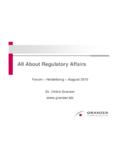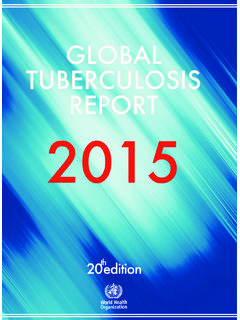Transcription of CHMP ASSESSMENT REPORT FOR Ellaone
1 European Medicines Agency Evaluation of Medicines for Human Use 7 Westferry Circus, Canary Wharf, London, E14 4HB, UK Tel. (44-20) 74 18 84 00 Fax (44-20) 75 23 70 51 E-mail: : EMEA/261787/2009 CHMP ASSESSMENT REPORT FOR Ellaone International Nonproprietary Name: ulipristal acetate Procedure No. EMEA/H/C/001027 ASSESSMENT REPORT as adopted by the CHMP with all information of a commercially confidential nature deleted. 2/49 TABLE OF CONTENTS 1. BACKGROUND INFORMATION ON THE PROCEDURE .. 3 Submission of the dossier .. 3 Steps taken for the ASSESSMENT of the 3 2.
2 SCIENTIFIC 4 4 Quality aspects .. 5 Non-clinical aspects .. 8 Clinical aspects .. 18 40 Overall conclusions, risk/benefit ASSESSMENT and recommendation .. 46 3/49 1. BACKGROUND INFORMATION ON THE PROCEDURE Submission of the dossier The applicant Laboratoire HRA Pharma submitted on 30 May 2008 an application for Marketing Authorisation to the European Medicines Agency (EMEA) for Ellaone , through the centralised procedure under Article 3 (2) (a) of Regulation (EC) No 726/2004. The eligibility to the centralised procedure was agreed upon by the EMEA/CHMP on 28 March 2007.
3 The legal basis for this application refers to: Article of Directive 2001/83/EC, as amended - complete and independent application The application submitted is a complete dossier composed of administrative information, complete quality data, non-clinical and clinical data based on applicants own tests and studies and/or bibliographic literature substituting/supporting certain tests or studies. Scientific Advice: The applicant did not seek scientific advice at the CHMP. Licensing status: The product was not licensed in any country at the time of submission of the application.
4 The Rapporteur and Co-Rapporteur appointed by the CHMP and the evaluation teams were: Rapporteur: Pieter de Graeff Co-Rapporteur: Tomas P Salmonson Steps taken for the ASSESSMENT of the product The application was received by the EMEA on 30 May 2008. The procedure started on 26 June 2008. The Rapporteur's first ASSESSMENT REPORT was circulated to all CHMP members on 15 September 2008. The Co-Rapporteur's first ASSESSMENT REPORT was circulated to all CHMP members on 19 September 2008. In accordance with Article 6(3) of Regulation (RC) No 726/2004, the Rapporteur and Co-Rapporteur declared that they had completed their ASSESSMENT REPORT in less than 80 days.
5 During the meeting on 20-23 October 2008, the CHMP agreed on the consolidated List of Questions to be sent to the applicant. The final consolidated List of Questions was sent to the applicant on 24 October 2008. The applicant submitted the responses to the CHMP consolidated List of Questions on 19 November 2008. The Rapporteurs circulated the Joint ASSESSMENT REPORT on the applicant s responses to the List of Questions to all CHMP members on 22 December 2008. During the CHMP meeting on 19-22 January 2009, the CHMP agreed on a list of outstanding issues to be addressed in writing and/or in an oral explanation by the applicant.
6 The applicant submitted the responses to the CHMP List of Outstanding Issues on 13 February 2009. The Rapporteurs circulated the ASSESSMENT REPORT on the applicant s responses to the List of Outstanding Issues to all CHMP members on 02 March 2009. During the meeting on 16-19 March 2009 the CHMP, in the light of the overall data submitted and the scientific discussion within the Committee, issued a positive opinion for granting a Marketing Authorisation to Ellaone on 19 March 2009. The applicant provided the letter of undertaking on the specific obligations and follow-up measures to be fulfilled post-authorisation on 17 March 2009.
7 4/49 2. SCIENTIFIC DISCUSSION Introduction Ellaone is a tablet containing 30 mg of micronized ulipristal acetate . The proposed indication is: Emergency contraception within 120 hours (5 days) of unprotected sexual intercourse or contraceptive failure. The proposed posology is one tablet to be taken orally as soon as possible, but no later than 120 hours (5 days) after unprotected intercourse or contraceptive failure. Despite the availability of highly effective methods of contraception, many pregnancies are unplanned. Emergency contraception (EC), defined as treatments aimed at preventing pregnancy after unprotected sexual intercourse, is an important means of preventing unwanted pregnancy following unprotected intercourse (UPI).
8 It is intended as a backup for occasional, emergency use only. The history of emergency contraception dates back to the 1960s when hormonal regimens were first introduced. Following the introduction of high-dose oestrogens, the so-called Yuzpe regimen, involving the combined use of oestrogen (100 microgram ethinylestradiol) and progestogen ( mg levonorgestrel or 1 mg dl-norgestrel) repeated once 12 hours apart with the first dose given within 72 hours of UPI, became popular in the late 70s and early 80s of last century1. The Yuzpe regimen was associated with a high incidence of nausea and vomiting due to the high oestrogen content.
9 Since 1990s the potential of levonorgestrel, a synthetic progestagen, was recognised and was set to replace the previous Yuzpe regimen of combined high-dose oral contraceptives. Levonelle-2 and Norlevo were approved in a two dose regimen by a mutual recognition procedure (UK/H/363/01 and FR/H/146/01 respectively), two doses of mg levonorgestrel, the first tablet to be taken within 72 hours of UPI and the second tablet 12 hours later. After studies showing the same efficacy of two doses of mg levonorgestrel 12 hours apart compared with mg levonorgestrel given at once, mg tablets of levonorgestrel were also granted marketing authorisation by a mutual recognition procedure (Norlevo FR/H/146/02 and Levonelle 1500 g UK/H/803/01).
10 Recent interest in the development of alternative regimens has led to trials of the antigonadotropin danazol, and antiprogestogens including mifepristone2, but not to marketing authorisation in the EU. Another option to prevent pregnancy after UPI is the postcoital insertion of a copper intra-uterine device (although not approved or labelled for such use) that can be used up to 5 days after the estimated time of ovulation, keeping it in the uterus as a long-term regular contraceptive method. The chemical structures of progesterone, mifepristone and ulipristal (CDB-2914) are shown in the figure below.














